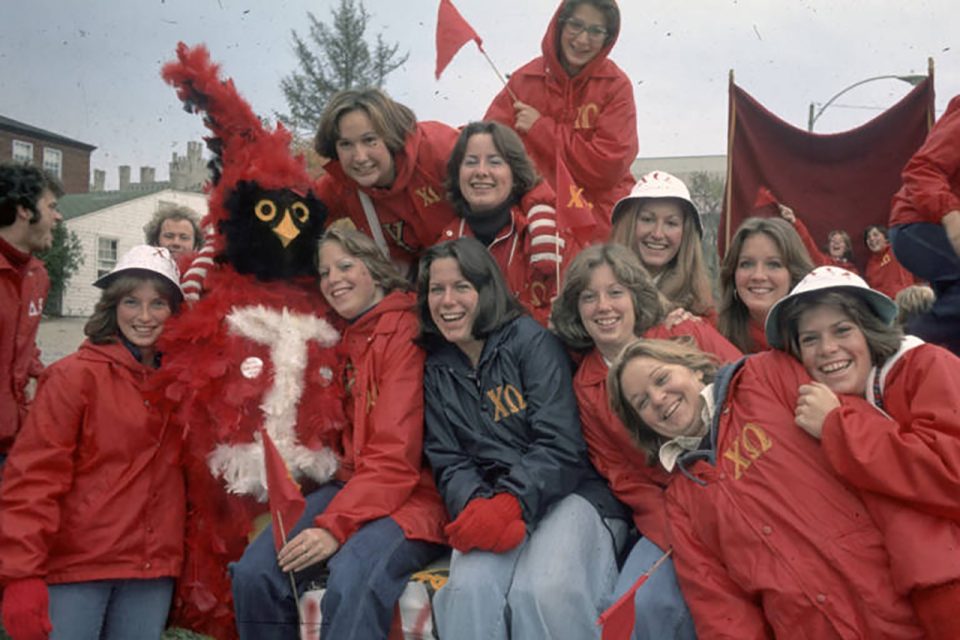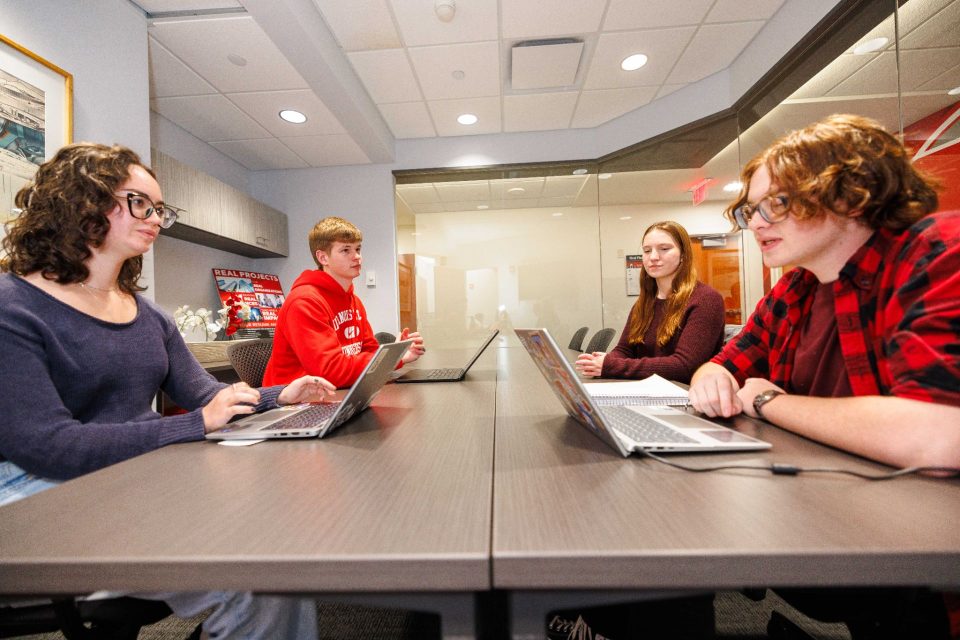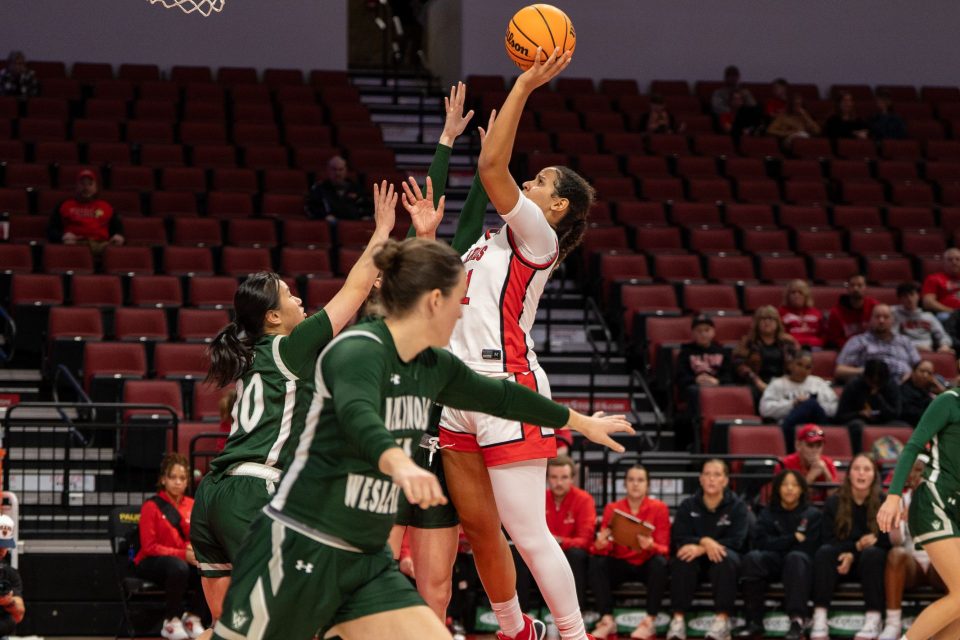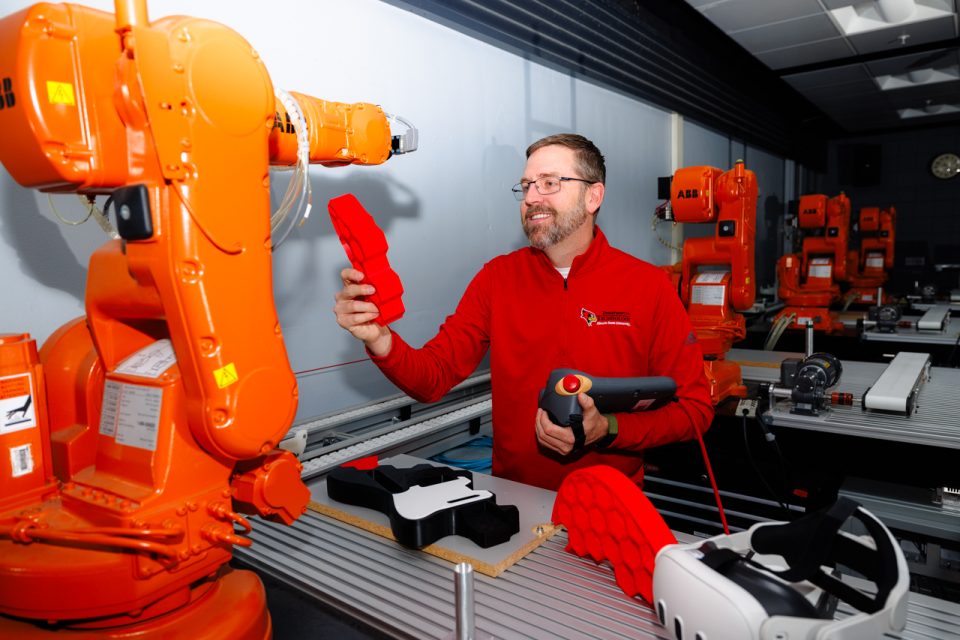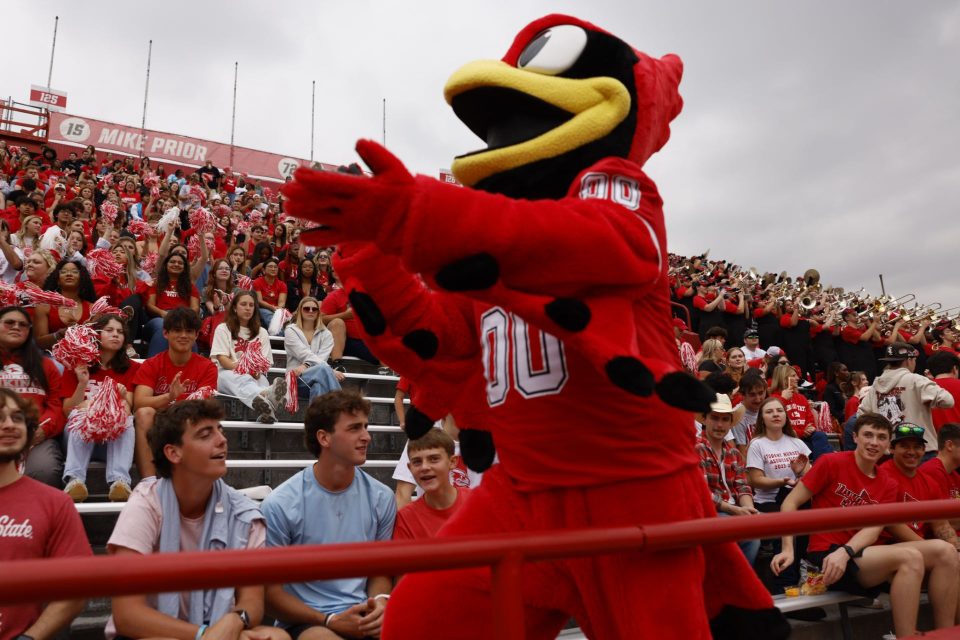This month in Illinois State University history: November
From a historic concert at Horton Field House, to a key game in the Redbirds’ longest football rivalry, historian Tom Emery explores this month in Illinois State University history.
November 3
On this date in 1968, singer Andy Williams, one of the top recording artists of his generation, performed a concert at Horton Fieldhouse.

Williams’ appearance at Illinois State came at the height of his fame, as he hosted a weekly television show from 1962-71 that earned three Emmy Awards. During the 1960s, he signed the largest recording contract in history at the time.
Williams is credited with 45 million record sales worldwide. In his lengthy career, he recorded 43 albums, including 15 gold records and three platinum albums.
The affable, easygoing Williams was a favorite of music fans of all ages and was known for his good relations with other Hollywood celebrities. His best-known hit, “Moon River,” is one of the most recognizable popular songs of all time.
The Illinois State appearance was the final date on a 13-day tour that also included country-novelty star Roger Miller, who is best known for his 1964 hit “King of the Road.” Members of a 26-piece orchestra that accompanied the stars flew into Bloomington-Normal Airport earlier on Sunday, the day of the concert. Later, Williams and Miller arrived by private jet from Kansas City, where they played the night before.
Williams and Miller held a press conference at the local Holiday Inn, where they also signed some autographs.
Once here, a recording representative, reporter, and driver spent an hour crisscrossing the Twin Cities to fill a special request from the singer: pumpkin seeds. One of Williams’ people said that he “has a new idea about health food” and was “on a health kick.”
As the Bloomington Pantagraph reported, though, “on that part of the mission the trio failed. Not a pumpkin seed around.” Sunflower seeds were suggested as a substitute, but every one that was found was salted, “certainly not the kind one could include in a health diet.”
There were other glitches, as one news reporter did not recognize Miller, who was “less than happy about (that) greeting.” Williams used his own sound system for the concert, and some fans complained that they could not hear much of the performance.
The concert was before a packed crowd in Horton, as the Pantagraph reported, “another row of people could not have been wedged in with anything less than a giant shoehorn.” Seeing the bleachers and basketball scoreboards of Horton, Williams joked that “this is the first time I’ve been invited to sing on Wide World of Sports.”
The Pantagraph reported that Williams won over the crowd “with his easygoing, soothing, and well-trained voice” and was particularly strong with an old favorite, “Danny Boy.” One concertgoer from Hudson wrote the Pantagraph that “it was the most ‘breathtaking’ performance ever.” Others in the crowd were no doubt in agreement.
November 4
On this date in 1921, the first-ever Homecoming at Illinois State began. The event was an overwhelming success and set the stage for the annual fall tradition that followed.

Homecoming had been celebrated on a smaller scale at Illinois State before 1921, including in 1916, when alumni were invited to a series of events, including a football game, dances, and a band. But the first true Homecoming was held in 1921, and was the brainchild of longtime university President David Felmley.
During a tour of the East Coast in the winter of 1920-21, Felmley noted the so-called “Homecoming Trend” of eastern schools, and thought that a similar event was needed at Illinois State. He came back to Normal and approved the concept, forming a committee to organize the affair.
The grand sum of $75 was allowed for expenses. The student body was highly enthused at the concept, which was reflected in an editorial of The Vidette on November 2, 1921.
Since “hundreds and hundreds of old graduates” would be in town, the paper implored the students to “meet every possible person that you can” with “a ready extended hand of welcome.” That, concluded the paper, “will be a real Homecoming.”
Alumni were met at the train station by students and faculty on the morning of Friday, November 4, and were treated to a full slate of activities. Registered guests in the main office were given a badge, a container of berries, and a souvenir booklet, created specially for the weekend.
A play, $1200 a Year, by the Jesters, a theatrical group, on Friday night was a smashing success; The Vidette called it “the greatest success of any play in our auditorium in a number of years” with a huge crowd in attendance. Afterward, an Auld Lang Syne party for alumni, students, and faculty was held in the art rooms of Old Main.

On Saturday morning, there was a waffle breakfast, served by female students of the Home Economics department, that attracted a crowd of 250. Many old friends gathered in Fell Hall, while more formal reunions were held in classrooms on the second floor in Old Main.
There, graduates of the 1860s and 1870s, the earliest classes at Illinois State, met in Room 12, while grads from the other decades met in separate groups. A football game between Illinois State and Eastern Illinois was the big draw on Saturday afternoon, and the home team thrilled the fans in a 42-3 blowout win.
The two longtime debating societies of the campus, the Philadelphians and Wrightonians, held special programs, while the library was open all day Friday and on Saturday morning for old friends to visit Miss Angeline Milner, the beloved university librarian. Favorable weather throughout the weekend helped in the festivities.
One of the quirks of the first Homecoming was the uncovering of a fruit cake that had been buried since before World War I. As The Vidette described, at midnight on July 16, 1917, some members of the Philadelphians had buried a fruit cake, “preserved in brandy” in a case, on the campus. However, the men became soldiers in the war, and the location of the fruit cake was forgotten.

In the spring of 1921, one of the students returned to campus and told the story of the fruitcake. As a result, The Vidette reported “it was then finally decided that the cake should be unearthed as part of the Homecoming program.” It was located on the south end of campus, where, “after digging for a few minutes,” the fruitcake was found, taken back to Old Main, and passed around at a meeting that evening.
Homecoming ended with a reception at Fell Hall on Saturday evening, which The Vidette called “a surging mass of dancers.” Breathlessly, The Vidette called the weekend “the greatest event ever held on the Normal campus,” an assessment that may be challenged by the many memorable Homecomings at Illinois State that have followed.
November 12
On this date in 1872, the first meeting of the Illinois State chapter of the Young Women’s Christian Association was held. The informal meeting was the origin of the nation’s first college chapter of the YWCA.
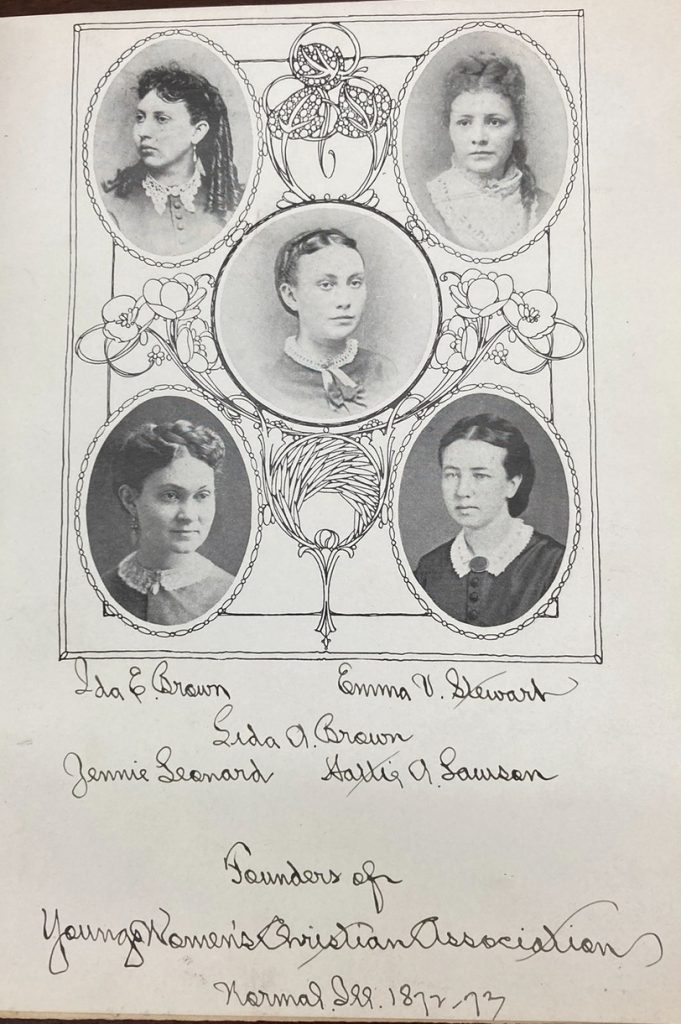
The driving force behind the Illinois State chapter of the YWCA was Lida Brown (later McMurry), who became one of the most influential women in early higher education in the state. Her devotion to the YWCA was sort of a family tradition.
Her brother, Isaac Eddy Brown, had been instrumental in the formation of the Illinois State chapter of the Young Men’s Christian Association, which first met at the Presbyterian Church on Linden Street in Normal in 1871. The Illinois State chapter of the YMCA was the first for a college in Illinois, and only the fifth nationwide.
Lida sought to form a similar chapter for women. In the 1907 semi-centennial history of Illinois State, President David Felmley set the scene, writing that “on a dismal Sunday afternoon in November 1872, a group of six young women met for prayer in the room of Miss Lida A. Brown.” Her quarters were in the home of Mrs. Charlotte McMurry, her future sister-in-law, at 512 North School Street.
Felmley continued that “they found the hour a profitable one, and believed that others should share in the blessings that they had received.” Inspired, the group invited all other women at Illinois State to join them, and the response was overwhelming. Soon, there were so many members that Lida’s small room could not accommodate them, and meetings were moved to the Congregational Church.
In 1873, that church was destroyed by fire, and meetings were temporarily held at the Methodist Church until a new Congregational facility could be constructed. The displacement did not stop the young women, though, as they formed a committee in early 1873 to draft a constitution.
On January 19 of that year, the group was formally organized as the Young Ladies Christian Association, the first college chapter in the nation.
Growth continued to skyrocket; in the first two years, some 120 female students had become members. In 1883, the club was renamed the Young Women’s Christian Association.
The Illinois State chapter of the YWCA had a sweeping impact on campus life. Felmley proudly wrote that “the entire school had received moral uplift through its presence” as a “vital force for good” that gave young women “higher ideals and broader conceptions of their life’s work.”
The YWCA of Illinois State, and elsewhere, was active in the temperance movement at the turn of the century. During World War I, the YWCA joined other organizations in Illinois State in renting plots of land in the southwest part of Normal to create gardens for the war effort. For many years, the group met in several rooms of a private residence at 320 North Street.
In September 1922, the YWCA of Illinois State held its 50th anniversary celebration with a banquet in Fell Hall that was planned for 400 attendees. The guest of honor was Lida Brown McMurry, the original founder, who graduated from Illinois State in 1874 and taught in various Illinois schools for 17 years until returning to Normal to join the faculty.
In 1900, she accepted a teaching position at Northern Illinois University, where a building, McMurry Hall, honors both her and her brother-in-law, Charles McMurry. It was one of many testaments to the legacy of Lida Brown McMurry, which included her beloved YWCA back in Normal.
November 25
On this date in 2006, Illinois State played at Eastern Illinois in the first round of the Football Championship Series (formerly Division I-AA) playoffs.
Illinois State came up with a pair of interception returns for touchdowns in a 24-13 victory in the most important matchup in the rivalry, the longest-running series in the history of Redbird football.
The schools first played in 1901, a 28-0 loss for Illinois State in the first of 113 times the schools have now played. Illinois State holds a 61-43-9 advantage in the series. It is the oldest Football Championship Series (formerly Division I-AA) in the state of Illinois, and the 13th-oldest FCS rivalry in the nation.

For many years, Illinois State and Eastern Illinois were in the same conference, adding flavor to the rivalry. There have been only 13 seasons since 1901 in which the two teams have not met.
With a series as long as the Illinois State-Eastern Illinois matchup, there have been plenty of memorable moments. In Charleston in 1915, the game ended in a scoreless tie as both teams fumbled inside the 10-yard line.
Though Illinois State first celebrated a full-scale Homecoming in 1921, there were elements of homecoming celebrations before that, including in 1916 with a football game against Eastern Illinois. Illinois State received a big special-teams play on a blocked punt for a touchdown that afternoon, but it was the only points they scored in a 24-7 loss.
However, Illinois State gained a measure of revenge at the real Homecoming five years later, with a 42-3 blowout victory.
The weather turned ugly in Normal on November 14, 1959, as the game was played in the snow, forcing Redbird linemen to wear gloves in a 6-6 tie. On September 30, 1961, the host Redbirds rolled to an 18-0 victory remembered for one memorable play, a touchdown pass estimated at 18 inches.
The Redbirds came up with longer plays in their next meeting with Eastern Illinois on September 29, 1962, as Paul Whitmore returned a punt 91 yards for a touchdown and the only points Illinois State needed in a 6-0 win. It remains the longest punt return for a touchdown in Illinois State history.
The meeting in the FCS playoffs in 2006 was part of a banner year for the rivalry, with two of the most noteworthy matchups in the history of the series. Illinois State and Eastern Illinois had also met in a regular-season contest on September 16, in Normal, when both teams came into the game nationally ranked for the first time ever in the rivalry. Illinois State, ranked No. 7, rallied from a 10-0 deficit after the first quarter for a 44-30 win over the No. 18-ranked Panthers.
In 2012, the game took on an official name, the Mid-America Classic. That same year, the teams celebrated by playing the highest-scoring contest in the history of the rivalry, as Illinois State won 54-51 in Normal. The 105 total points smashed the old record of 85, set in a 44-41 Illinois State win at Normal in 2000.
There has been one Illinois State-Eastern Illinois meeting that was decided in overtime, when the Redbirds pulled out a 34-31 win at Charleston on Sept. 20, 2015. It was just one of many memorable moments in the series between Illinois State and its longest-running rival, Eastern Illinois.
With Illinois State’s 42-30 win over Eastern Illinois earlier this season, the Redbirds have now won seven of the past eight meetings against the Panthers, and nine out of the past 11 overall.
Tom Emery is a freelance writer and historical researcher who, in collaboration with Carl Kasten ’66, co-authored the 2020 book Abraham Lincoln and the Heritage of Illinois State University.
Latest Campus News
- Highly anticipated men’s basketball season set to tip offThe journey to playing basketball in March starts with a single step in November. For the Missouri Valley Conference preseason favorite-Illinois State University men’s basketball team, that means opening the season November 6 at Ohio University before tipping off the home schedule November 9 against Cornell.
- Innovation in action: Hagge Innovation Institute fosters real-world problem solvingDani Hartmann '24 and Luke Graf '21 are two of the hundreds of students who have developed their skills and boosted their resumes through the Hagge Innovation Institute, which celebrated its third anniversary this month.
- Young, gritty Redbird women’s basketball team begins the road to MarchWhen the Illinois State University women’s basketball team opens the regular season on Monday, November 3, at CEFCU Arena against Dayton, head coach Kristen Gillespie will be glad to have a couple of veteran players on the floor to lend their leadership to a young team.
- Five questions with Dr. Jeritt Williams, engineering technology prof who trains future experts in robotics and automationA three-time alum of Illinois State University, Dr. Jeritt Williams ’07, M.S. ’12, Ed.D. ’24, is the the 2025 Association for Advancing Automation Educator of the Year.
- Homecoming 2025 highlights: The photos, posts that raised the bannerRedbirds near and far returned to campus to Raise the Banner for Illinois State University’s Homecoming 2025. Check out this year’s roundup of some of the best posts and photos shared throughout #RedbirdHomecoming week.
- New engineering student is an award-winning inventor inspired by his own diabetic journeyStephen Reuter, an 18-year-old freshman general engineering student at Illinois State University, may be at the starting line of his training, but he understands more than most people the meaning of the old adage: “Necessity is the mother of invention.”



